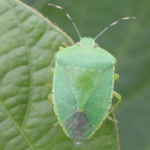Many soybeans in Tennessee have entered the reproductive stages and this is a critical time for scouting insects. This is especially true for fields in the later development stages with seed forming in pods as they are very attractive to several species of stink bugs, which are seed feeders.

The most common insect pest in our soybeans is green stink bug. We can also have brown stink bugs, brown marmorated stink bugs, and a few other less common species. The best way to determine what insects are present in our beans is with a sweep net. Just as a reminder, adult and immature stink bugs both count toward the treatment threshold of 9 per 25 sweeps in R1-R6 soybeans. UT recommends doing 4 sets of 25 sweeps in representative parts of the field, not just edges or middles. We know getting to the middles of most narrow row fields is not always practical, but do the best you can. Most pyrethroid insecticides work well on green stink bugs. However, be mindful if you have a fair number of brown stink bugs (20 – 30%). In this case, bifenthrin or acephate will do better at controlling both green and brown stink bugs.
Populations of kudzu bugs are also increasing in some areas. Adults and egg clusters are not difficult to find in soybean locally. Do not trigger an application on adults, only nymphs. Treatment is warranted if you average 1 nymph per sweep (or 25 nymphs per 25 sweeps). Products with the active ingredient bifenthrin are hard to beat at 5-6 oz/acre, but most pyrethroid insecticides generally provide good control with the exception of cyfluthrin (e.g., Baythroid XL and Tombstone).

